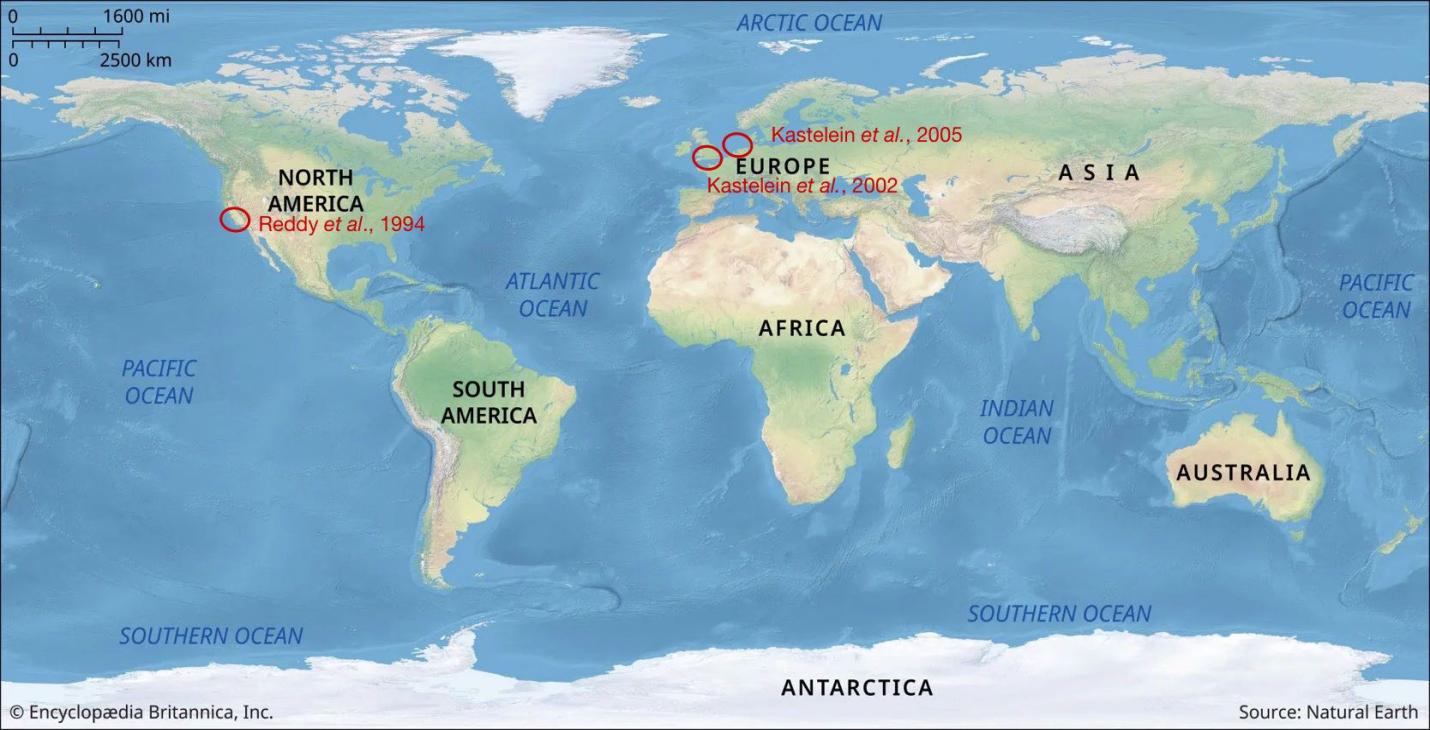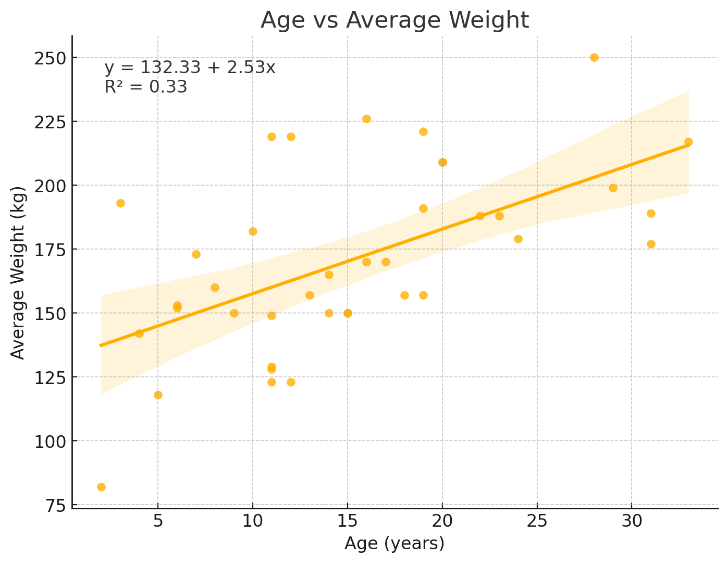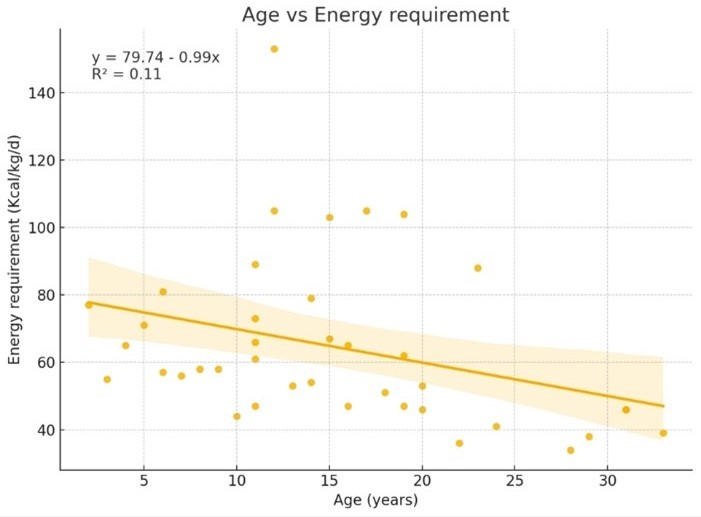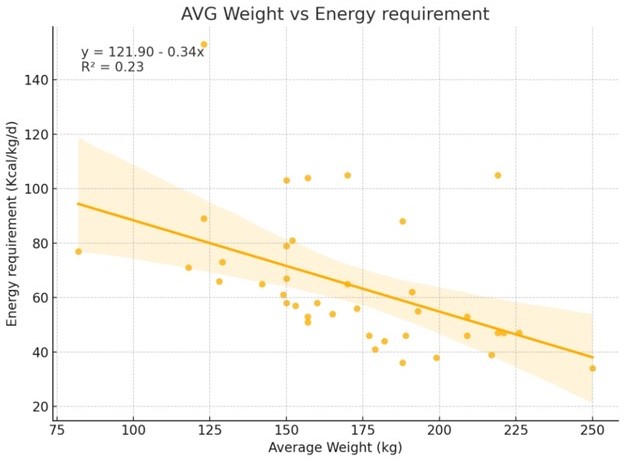1. Introduction
The common bottlenose dolphin (Tursiops truncatus) is one of the most recognizable and arguably the best-known species among all cetaceans, frequently featured in documentaries and accessible for interaction in zoos and aquariums [1]. These agile creatures captivate people’s attention with their beauty and intelligence. This research examines the relationships among age (in years), weight (in kg), and energy requirements (in Kcal/kg/day) of captive common bottlenose dolphins. An appropriate amount of energy intake and a balanced nutrient diet are essential for maintaining the health and wellness of the common bottlenose dolphin [2].
Common bottlenose dolphins experience several distinct developmental stages from birth to maturity, each characterized by unique energy requirements influenced by age, growth, and reproductive status. Initially, newborns rely on maternal care, transitioning to consuming solid food as calves [3]. As these young dolphins grow, understanding their dietary needs becomes increasingly crucial. During the juvenile stage, dolphins gain independence, refining hunting, and social skills, while adolescents approach adult size and sexual maturity [4]. They typically attain sexual maturity around ten years of age, with females reaching fertility between 5 to 10 years earlier than males, who mature between 8-13 years [5]. As adults, dolphins reach full size, with males typically larger than females, and engage in established social and reproductive behaviors [4]. This progression underscores the need to explore how these factors collectively impact energy consumption and overall health. Body size, particularly weight, plays a critical role in determining the energy requirements of common bottlenose dolphins. Various factors, including age, food consumption, and habitat, influence the weight of these dolphins, which typically ranges from 150 to 200 kg [6]. There are individual differences in the weight of common bottlenose dolphin; large bottlenose dolphins in the Pacific may reach 454 kg, and the maximum weight reported was an Eastern North Atlantic individual, who measured 650 kg [6]. This variation in weight among individuals highlights the complexity of accurately assessing and meeting their energy needs.
To maintain optimal health and well-being, the diet of common bottlenose dolphins must be carefully managed to reflect their diverse nutritional needs. Common bottlenose dolphins exhibit dietary diversity, preying on a variety of species like fish, squid, and crustaceans, with preferences often dictated by geographic location and local prey availability [7]. In their natural habitat, dolphins hunt their prey opportunistically. However, captive dolphins are reliant on the fish provided to them. The transition from natural hunting to captivity necessitates careful dietary planning. Trainers and veterinarians who are responsible for their care face the task of ensuring that the dolphins receive the optimal diet, comprising a variety and sufficient quantity of fish to fulfill all their nutritional requirements [2]. Overfeeding can lead to obesity and associated health issues while underfeeding or nutrient deficiencies can result in malnutrition and severe health problems.
As bottlenose dolphins are increasingly held in captivity for both conservation and research purposes, there has been a significant accumulation of data concerning their physical and behavioral characteristics [8, 9, 10, 11]. Most of this extensive data set has been meticulously recorded and thoroughly analyzed, providing valuable insights into various aspects of their physiology, behavior, and well-being. Despite this abundance of data, specific insights into how developmental stages affect energy requirements are scant [2]. This article aims to bridge this gap by conducting a comparative analysis of the energy requirements of common bottlenose dolphins in terms of their age and weight based on previous studies. By enhancing people’s understanding of these relationships, this research can significantly improve conservation efforts, refine welfare practices, and deepen the comprehension of these remarkable marine mammals.
2. Method
2.1. Study Articles and Data Sources
This article analyzes three longitudinal studies that examine the age, food consumption, and body measurements of captive common bottlenose dolphins in three nations [2, 12, 13]. Kastelein et al., 2002 report the body measurement and food consumption data of 19 Atlantic bottlenose dolphins housed at Harderwijk Marine Mammal Park in the Netherlands from 1965 to 1995. Kastelein et al., 2005 report a similar set of data of 11 Atlantic bottlenose dolphins kept at Windsor Safari Park, UK, from 1979 to 1993/1994, and at Harderwijk Marine Mammal Park in the Netherlands from 1993/1994 to 1995. Reddy et al., 1994 report the body measurement data and the energy requirement of 16 bottlenose dolphins housed in a netted enclosure in San Deigo Bay from 1989 to 1991. All three studies include subadult male and female dolphins, as well as pregnant and lactating female dolphins.
2.2. Sample Measurement and Data Collection
This article includes data samples of common bottlenose dolphins of various ages and both sexes. Eight data samples were collected from Kastelein et al., 2002 (TtWs001, TtWs 005, TtWs006, TtWs007, TtWs008, TtWs002, TtWs003, TtWs010), five data samples were collected from Kastelein et al., 2005 (TtZH006, TtZH010, TtZH007, TtWS005, TtWS007), and all the data sample were collected from Reddy et al., 1994. Some data were listed in the table of the three studies, but more were extracted from graphs by extrapolating data points and comparing them with the axes. Existing data were recorded directly, while relevant raw data were processed and integrated to create the individual information table (Appendices, Table 1).
2.3. Data Processing and Data Analysis
All dolphins that have recorded age, body measurements, and food intake or energy requirements simultaneously from the three studies were collected to serve as the data sample for this research. Their serial number listed in previous studies were used again as their identity. For dolphins with recorded ages falling within a range, the median of that range is used as their official recorded age. If the median results in a decimal, it is rounded up to the nearest whole number. The weight of bottlenose dolphins in kg, defined as the average weight of an individual at a specific age, can be calculated from their body length using the equation body mass = 17.261e0.0156(body length - 100) [12]. The energy requirement in Kcal/kg/day for bottlenose dolphins is calculated by multiplying the daily food consumption weight by the caloric content of the consumed food, specifically the calories of the percentage of the fish or squid per kilo, and then dividing the result by the dolphin’s average body weight, finalizing all data as Kcal/kg/day [12, 13, 14].
The R package [15] is used to analyze all data collected from the three kinds of literature, comparing the relationships among age (in years), average weight (in kg), and energy requirement (in Kcal/kg/day). A linear modeling method was employed to generate regression equations based on the data recorded in the individual information table. The coefficient determination (R²) was computed from the regression plots to assess the strength of the correlation between the dependent variable on the y-axis and the independent variable on the x-axis.
3. Result
3.1. Geographic distribution and timeline of data collection caused a high variance of food resource
This research incorporates data derived from three significant longitudinal studies conducted over a broad geographic distribution and time span, highlighting diverse environments and dolphin populations. (Figure 1). The world map provided in Figure 1 illustrates the geographic distribution of the studies, with red circles indicating the specific locations where each study was conducted. This visual representation highlights the global nature of the research efforts and underscores the environmental variations that may influence the observed outcomes in dolphin physiology and behavior. Kastelein et al., 2002 and 2005 conducted in Europe, these studies spanned from the late 1960s to the early 1990s. They provided comprehensive data on dolphin body measurements and dietary habits across several decades, offering a longitudinal perspective on the physiological and behavioral trends within captive dolphin populations. Reddy et al., 1994 conducted this study in North America in the early 1990s, marked on the map in Figure 1. The geographic diversity of these studies is crucial for understanding regional variations in captive dolphin care and health, providing insights that are likely applicable across different dolphin populations worldwide.

Figure 1. Geographic distribution of locations where selected research was performed on captive bottlenose dolphin
The analysis of daily food composition across different studies and periods reveals significant shifts in dietary management strategies for common bottlenose dolphins. These shifts are documented in Figures 2, 3, and 4, the total energy content of 1 kg of daily consumed food was calculated for periods before and after 1991, as reported by Kastelein et al., 2002, with values of 1685 Kcal/day and 1768 Kcal/day, respectively. In Kastelein et al., 2005, it was 1682 Kcal/day. These values were calculated separately and integrated into pie charts (Figure 5, Figure 6, Figure 7) to illustrate the differences in dietary composition over the years. Before 1991, the diet predominantly consisted of herring (65%) and mackerel (30%), with squid comprising only 5% of the total. Herring and mackerel, known for their high caloric value of 1580 Kcal/kg and 2050 Kcal/kg respectively, suggest a diet aimed at maximizing caloric intake, which could be indicative of a focus on growth or high-energy demands. The dietary composition after 1991 shows a reduced proportion of herring (60%) and an increase in mackerel (40%). By 1993, as illustrated in Figure 4, the diet diversified significantly, with the introduction of new fish types such as whiting and sprat, which account for 20% and 15% of the diet, respectively. The inclusion of sprat, particularly high in calories (2080 Kcal/kg), alongside the consistent presence of herring and mackerel, indicates an adaptive approach to dietary planning that possibly considers the varying nutritional needs of dolphins at different life stages or health conditions.
Figure 2. One kg daily food composition before 1991 from Kastelein et al., 2002
Figure 3. One kg daily food composition after 1991 from Kastelein et al., 2002
Figure 4. One kg daily food composition in 1993 from Reddy et al., 1994
Across all figures, the data demonstrate a gradual evolution from a heavy herring and mackerel-based diet to a more diversified approach including lower-calorie fishlike squid and whiting. This transition in dietary components likely mirrors changes in dietary research, understanding of dolphin health needs, and possibly the influence of conservation practices on food sourcing.
3.2. Age positively influences body weight in common bottlenose dolphins
An individual information table (Table 1) was created based on processed data from 39 data samples of common bottlenose dolphins. This table lists the identity (serial number), age (in years), average weight (in kg), and energy requirement (in Kcal/kg/day) of the 39 data samples. Furthermore, to explore the relationships among the recorded data, three linear regression plots were generated to analyze: (1) the correlation between age (in years) and average weight (in kg) (Figure 5), (2) the correlation between age (in years) and energy requirement (in Kcal/kg/day) (Figure 6), and (3) the correlation between average weight (in kg) and energy requirement (in Kcal/kg/day) of bottlenose dolphins (Figure 7).

Figure 5. The relationship between age (in years) and average weight (in kg) of captive common bottlenose dolphin

Figure 6. The relationship between age (in years) and energy requirement (in Kcal/kg/day) of captive common bottlenose dolphin

Figure 7. The relationship between average weight (in kg) and energy requirement (in Kcal/kg/day) of captive bottlenose dolphin
As shown in Figure 5, the age (in years) and average weight (in kg) of common bottlenose dolphins show a positive correlation with the regression equation y = 132.33 + 2.53x, indicating that older dolphins tend to have a larger body size. However, the data poorly fit the regression model (R² value is 0.33), this might be due to the limited size of samples and big variation among the collected samples. The scattered data points on the plot highlight significant individual differences in weight among dolphins of all ages. For instance, the heaviest dolphin weighs 250 kg before its 30s, while the lightest dolphin weighs only 82 kg when it is two years old.
Among the three regression models, the relationship between age (in years) and average weight (in kg) of common bottlenose dolphins presents the highest correlation, with an R² value of 0.33. This suggests that older dolphins tend to have larger body sizes.
3.3. Age and body weight negatively influence energy consumption
It was indicated before that increasing age and higher body weight during adulthood can negatively influence energy consumption requirements in bottlenose dolphins, likely due to metabolic changes and higher maintenance costs, respectively [16]. In this investigation, a similar trend was observed that aligns with the previous conclusion. As depicted in Figure 6, there is a negative correlation between the age (in years) of common bottlenose dolphins and their energy requirement (in Kcal/kg/day), represented by the regression equation y = 79.74 – 0.99x. Generally, common bottlenose dolphins younger than 20 years old have higher energy requirements than those older than 20 years old. However, the fitness of the correlation is not high (R² = 0.11), this might be due to the following reason: Lactating female dolphins have significantly higher energy requirements, consistent with previous studies; the data in this research also includes subadult males, which might also have a negative influence on the fitness of the data points to the trend [2].
As illustrated in Figure 7, there is a negative correlation between the average weight (in kg) of common bottlenose dolphins and their energy requirement (in Kcal/kg/day), with the regression equation y = 121.90 – 0.34x. This indicates that larger dolphins require less energy per kilogram of body weight compared to smaller, lighter dolphins. Several data points from lactating female dolphins, who, despite having similar weights to others, require much more energy could be considered outliers in the following study. Eliminating those data of lactating females could significantly increase the R2 value.
4. Discussion
This investigation reveals a general pattern across several similar research, contributing to further understanding of nutrient supply of captive common bottlenose dolphins. The positive correlation between the age and average weight of bottlenose dolphins coincides with the expectations and aligns with previous studies [3]. This relationship indicates that, as dolphins age, they tend to gain weight, reflecting their growth and development stages. Although the body size of common bottlenose dolphins varies depending on age, energy intake, and habitat, they generally reach a weight threshold between 200 and 250 kg. Most common bottlenose dolphin in captivity falls within the range of 150 to 200 kg [6]. The weight threshold suggests that while dolphins continue to grow with age, their weight stabilizes as they reach adulthood. The negative correlations observed between age and energy requirement, as well as weight and energy requirement, are also consistent with findings from previous studies [17]. As common bottlenose dolphins age, they exhibit a decrease in energy requirements, and heavier dolphins typically require less energy per kilogram than their lighter counterparts. These findings are consistent with previous research, affirming that data from dolphins at various developmental stages and conditions reflect accurate trends. However, the weaker correlations observed highlight the complexities of how age, weight, and reproductive status interact to influence energy needs.
During data collection and analysis, several limitations were encountered. Firstly, inconsistency in data reporting among the three studies, with some data directly listed in tables while others required extraction from graphs, increased the risk of errors during interpretation. Additionally, variations in geographic locations and periods of the studies, spanning from 1965 to 1995, introduced variability due to differing environmental conditions and measurement techniques [13]. Furthermore, the inclusion of diverse dolphin populations, such as subadult, adult, pregnant, and lactating dolphins, added complexity to the analysis, with lactating females notably exhibiting significantly higher energy requirements and thus affecting the correlation coefficient. However, each growth stage data sample number is not high enough to conduct a trustworthy analysis of each development phase. Additionally, the simplified method of recording age and using equations to estimate weight assumed consistent growth patterns, potentially overlooking individual variations. Finally, the linear modeling method used may not fully capture the complexities in the relationships between age, weight, and energy requirements. Including a more complex model might introduce a higher fitness among these three factors.
There are more factors that can be included in a complex fitness model, such as the activity level of common bottlenose dolphins. However, there are a few studies that described this category for wild bottlenose dolphins and only some for those in captivity [18].
To advance and refine future studies, the following aspects can be considered. First of all, it is imperative to gather a more extensive range of data samples from common bottlenose dolphins worldwide to provide a better general perspective for captivation. Secondly, adopting a consistent methodology for measuring the body size and energy requirements of bottlenose dolphins across studies can significantly eliminate human error in measurement. Additionally, maintaining consistency in the types of food used to feed all dolphins involved in the research is also crucial for ensuring a constant energy intake. Furthermore, lactating and pregnant female dolphin samples should be documented separately, as this special body condition can significantly skew the analysis result. By standardizing these methods and expanding the scope of data collection, future studies can achieve greater accuracy and comprehensiveness in their analyses.
5. Conclusion
This article underscores the significance of comprehending the physical characteristics and energy requirements of captive common bottlenose dolphins, offering valuable insights applicable to both research and practical feeding strategies. Age and weight negatively influence the energy consumption of dolphins, and age vs weight are positively correlated with each other. This research illustrates how including subadult male and female dolphins, pregnant and lactating female dolphins affects data analysis and the correlations among age, weight, and energy requirement, urging researchers to consider sample composition carefully. To enhance future studies, it is recommended to employ standardized methodologies for measurement and sample selection, along with broader data sources. This approach ensures accuracy and representativeness, thereby advancing people’s understanding of dolphin physiology, aiding conservation efforts, and enhancing welfare practice.
References
[1]. Wells, R. S., & Scott, M. D. (2009). Common bottlenose dolphin: Tursiops truncatus. Encyclopedia of Marine Mammals, January 2009, 249–255. https://doi.org/10.1016/B978-0-12-373553-9.00062-6
[2]. Reddy, M., Kamolnick, T., Curry, C., Skaar, D., & Ridgeway, S. (1994). Energy requirements
[3]. for the bottlenose dolphin (Tursiops truncatus) in relation to sex, age, & reproductive status. Marine Mammals: Public Display and Research, 1(1), 26–31.
[4]. Cockcroft, V. G., & Ross, G. J. B. (1990). Observations on the Early Development of a Captive Bottlenose Dolphin Calf. The Bottlenose Dolphin, 461–478. https://doi.org/10.1016/b978-0-12-440280-5.50031-7
[5]. Fagaly, S. (2023). What are the life and death phases of a Dolphin? - Dolphins And You. https://www.dolphinsandyou.com/life-phases-of-a-dolphin/
[6]. Bottlenose Dolphin (U.S. National Park Service). (2023). https://www.nps.gov/places/bottlenose-dolphin.htm
[7]. All About Bottlenose Dolphins - Physical Characteristics | United Parks & Resorts. (n.d.). (2024). https://seaworld.org/animals/all-about/bottlenose-dolphin/characteristics/
[8]. Spitz, J., Mourocq, E., Leauté, J. P., Quéro, J. C., & Ridoux, V. (2010). Prey selection by the common dolphin: Fulfilling high energy requirements with high quality food. Journal of Experimental Marine Biology and Ecology, 390(2), 73–77. https://doi.org/10.1016/j.jembe.2010.05.010
[9]. Adamczak, S. K., Holser, R. R., Costa, D. P., Berens McCabe, E. J., & Wells, R. S. (2021). Body Composition of Common Bottlenose Dolphins in Sarasota Bay, Florida. Frontiers in Marine Science, 8(June), 1–12. https://doi.org/10.3389/fmars.2021.615773
[10]. Hanson, M., & Defran, R. (1993). The behavior and feeding ecology of the Pacific coast bottlenose dolphin, Tursiops truncatus. In Aquatic Mammals, 19, 127–142. http://aquaticmammalsjournal.org/share/AquaticMammalsIssueArchives/1993/Aquatic_Mammals_19_3/19-03_Hanson.pdf
[11]. Hart, L. B., Wells, R. S., & Schwacke, L. H. (2013). Reference ranges for body condition in wild bottlenose dolphins Tursiops truncatus. Aquatic Biology, 18(1), 63–68. https://doi.org/10.3354/ab00491
[12]. Piwetz, S. (2019). Common bottlenose dolphin (Tursiops truncatus) behavior in an active narrow seaport. PLoS ONE, 14(2), 1–23. https://doi.org/10.1371/journal.pone.0211971
[13]. Kastelein, R. A., Vaughan, N., Walton, S., & Wiepkema, P. R. (2002). Food intake and body measurements of Atlantic bottlenose dolphins (Tursiops truncates) in captivity. Marine Environmental Research, 53(2), 199–218. https://doi.org/10.1016/S0141-1136(01)00123-4
[14]. Kastelein, R. A., Staal, C., & Wiepkema, P. R. (2005). Food consumption, food passage time, and body measurements of captive Atlantic bottlenose dolphins (Tursiops truncatus). Aquatic Mammals, 29(1), 53–66. https://doi.org/10.1578/016754203101024077
[15]. FoodData Central. (n.d.). (2024). https://fdc.nal.usda.gov/fdc-app.html#/food-details/175116/nutrients
[16]. R Core Team (2021). R: A language and environment for statistical computing. R Foundation for Statistical Computing, Vienna, Austria. URL https://www.R-project.org/. Rimbach, R., Amireh, A., Allen, A., Hare, B., Guarino, E., Kaufman, C., Salomons, H., & Pontzer, H. (2021). Total energy expenditure of bottlenose dolphins (Tursiops truncatus) of different ages. Journal of Experimental Biology, 224(15), 1–12. https://doi.org/10.1242/jeb.242218
[17]. Rossman, S., Berens Mccabe, E., Barros, N. B., Gandhi, H., Ostrom, P. H., Stricker, C. A., & Wells, R. S. (2015). Foraging habits in a generalist predator: Sex and age influence habitat selection and resource use among bottlenose dolphins (Tursiops truncatus). Marine Mammal Science, 31(1), 155–168. https://doi.org/10.1111/mms.12143
[18]. Lauderdale, L. K., Alex Shorter, K., Zhang, D., Gabaldon, J., Mellen, J. D., Walsh, M. T., Granger, D. A., & Miller, L. J. (2021). Bottlenose dolphin habitat and management factors related to activity and distance traveled in zoos and aquariums. PLoS ONE, 16(8), 1–19. https://doi.org/10.1371/journal.pone.0250687
Cite this article
Sun,Y. (2024). Comparative analysis of the relationship among age, weight, and energy requirement of common bottlenose dolphin (Tursiops truncatus). Theoretical and Natural Science,62,105-115.
Data availability
The datasets used and/or analyzed during the current study will be available from the authors upon reasonable request.
Disclaimer/Publisher's Note
The statements, opinions and data contained in all publications are solely those of the individual author(s) and contributor(s) and not of EWA Publishing and/or the editor(s). EWA Publishing and/or the editor(s) disclaim responsibility for any injury to people or property resulting from any ideas, methods, instructions or products referred to in the content.
About volume
Volume title: Proceedings of the 4th International Conference on Biological Engineering and Medical Science
© 2024 by the author(s). Licensee EWA Publishing, Oxford, UK. This article is an open access article distributed under the terms and
conditions of the Creative Commons Attribution (CC BY) license. Authors who
publish this series agree to the following terms:
1. Authors retain copyright and grant the series right of first publication with the work simultaneously licensed under a Creative Commons
Attribution License that allows others to share the work with an acknowledgment of the work's authorship and initial publication in this
series.
2. Authors are able to enter into separate, additional contractual arrangements for the non-exclusive distribution of the series's published
version of the work (e.g., post it to an institutional repository or publish it in a book), with an acknowledgment of its initial
publication in this series.
3. Authors are permitted and encouraged to post their work online (e.g., in institutional repositories or on their website) prior to and
during the submission process, as it can lead to productive exchanges, as well as earlier and greater citation of published work (See
Open access policy for details).
References
[1]. Wells, R. S., & Scott, M. D. (2009). Common bottlenose dolphin: Tursiops truncatus. Encyclopedia of Marine Mammals, January 2009, 249–255. https://doi.org/10.1016/B978-0-12-373553-9.00062-6
[2]. Reddy, M., Kamolnick, T., Curry, C., Skaar, D., & Ridgeway, S. (1994). Energy requirements
[3]. for the bottlenose dolphin (Tursiops truncatus) in relation to sex, age, & reproductive status. Marine Mammals: Public Display and Research, 1(1), 26–31.
[4]. Cockcroft, V. G., & Ross, G. J. B. (1990). Observations on the Early Development of a Captive Bottlenose Dolphin Calf. The Bottlenose Dolphin, 461–478. https://doi.org/10.1016/b978-0-12-440280-5.50031-7
[5]. Fagaly, S. (2023). What are the life and death phases of a Dolphin? - Dolphins And You. https://www.dolphinsandyou.com/life-phases-of-a-dolphin/
[6]. Bottlenose Dolphin (U.S. National Park Service). (2023). https://www.nps.gov/places/bottlenose-dolphin.htm
[7]. All About Bottlenose Dolphins - Physical Characteristics | United Parks & Resorts. (n.d.). (2024). https://seaworld.org/animals/all-about/bottlenose-dolphin/characteristics/
[8]. Spitz, J., Mourocq, E., Leauté, J. P., Quéro, J. C., & Ridoux, V. (2010). Prey selection by the common dolphin: Fulfilling high energy requirements with high quality food. Journal of Experimental Marine Biology and Ecology, 390(2), 73–77. https://doi.org/10.1016/j.jembe.2010.05.010
[9]. Adamczak, S. K., Holser, R. R., Costa, D. P., Berens McCabe, E. J., & Wells, R. S. (2021). Body Composition of Common Bottlenose Dolphins in Sarasota Bay, Florida. Frontiers in Marine Science, 8(June), 1–12. https://doi.org/10.3389/fmars.2021.615773
[10]. Hanson, M., & Defran, R. (1993). The behavior and feeding ecology of the Pacific coast bottlenose dolphin, Tursiops truncatus. In Aquatic Mammals, 19, 127–142. http://aquaticmammalsjournal.org/share/AquaticMammalsIssueArchives/1993/Aquatic_Mammals_19_3/19-03_Hanson.pdf
[11]. Hart, L. B., Wells, R. S., & Schwacke, L. H. (2013). Reference ranges for body condition in wild bottlenose dolphins Tursiops truncatus. Aquatic Biology, 18(1), 63–68. https://doi.org/10.3354/ab00491
[12]. Piwetz, S. (2019). Common bottlenose dolphin (Tursiops truncatus) behavior in an active narrow seaport. PLoS ONE, 14(2), 1–23. https://doi.org/10.1371/journal.pone.0211971
[13]. Kastelein, R. A., Vaughan, N., Walton, S., & Wiepkema, P. R. (2002). Food intake and body measurements of Atlantic bottlenose dolphins (Tursiops truncates) in captivity. Marine Environmental Research, 53(2), 199–218. https://doi.org/10.1016/S0141-1136(01)00123-4
[14]. Kastelein, R. A., Staal, C., & Wiepkema, P. R. (2005). Food consumption, food passage time, and body measurements of captive Atlantic bottlenose dolphins (Tursiops truncatus). Aquatic Mammals, 29(1), 53–66. https://doi.org/10.1578/016754203101024077
[15]. FoodData Central. (n.d.). (2024). https://fdc.nal.usda.gov/fdc-app.html#/food-details/175116/nutrients
[16]. R Core Team (2021). R: A language and environment for statistical computing. R Foundation for Statistical Computing, Vienna, Austria. URL https://www.R-project.org/. Rimbach, R., Amireh, A., Allen, A., Hare, B., Guarino, E., Kaufman, C., Salomons, H., & Pontzer, H. (2021). Total energy expenditure of bottlenose dolphins (Tursiops truncatus) of different ages. Journal of Experimental Biology, 224(15), 1–12. https://doi.org/10.1242/jeb.242218
[17]. Rossman, S., Berens Mccabe, E., Barros, N. B., Gandhi, H., Ostrom, P. H., Stricker, C. A., & Wells, R. S. (2015). Foraging habits in a generalist predator: Sex and age influence habitat selection and resource use among bottlenose dolphins (Tursiops truncatus). Marine Mammal Science, 31(1), 155–168. https://doi.org/10.1111/mms.12143
[18]. Lauderdale, L. K., Alex Shorter, K., Zhang, D., Gabaldon, J., Mellen, J. D., Walsh, M. T., Granger, D. A., & Miller, L. J. (2021). Bottlenose dolphin habitat and management factors related to activity and distance traveled in zoos and aquariums. PLoS ONE, 16(8), 1–19. https://doi.org/10.1371/journal.pone.0250687









